Q: What procedures do officers follow during a traffic stop when they suspect DUI?
During a traffic stop in California when officers suspect DUI, they follow specific procedures to assess the situation and ensure the safety of everyone involved. Initially, the officer will approach the vehicle and observe the driver’s behavior, looking for signs of impairment such as slurred speech, bloodshot eyes, or an odor of alcohol. They may also ask the driver a series of questions about their alcohol consumption and driving history.
If an officer suspects that a driver is under the influence based on initial observations, they will likely request the driver to exit the vehicle. This is typically followed by the administration of field sobriety tests, which may include tasks that assess the driver’s physical coordination and focus. Common tests include the Walk-and-Turn, One-Leg Stand, and the Horizontal Gaze Nystagmus. These tests are used to help determine the driver’s level of impairment.
If the officer finds enough evidence to believe the driver is impaired, they can then proceed to arrest the individual and take them into custody. Following the arrest, a chemical test will usually be administered, which can include a breathalyzer or a blood test, to measure the blood alcohol concentration (BAC) of the driver. California law mandates that drivers submit to these chemical tests, and refusal can lead to additional penalties, including license suspension.






